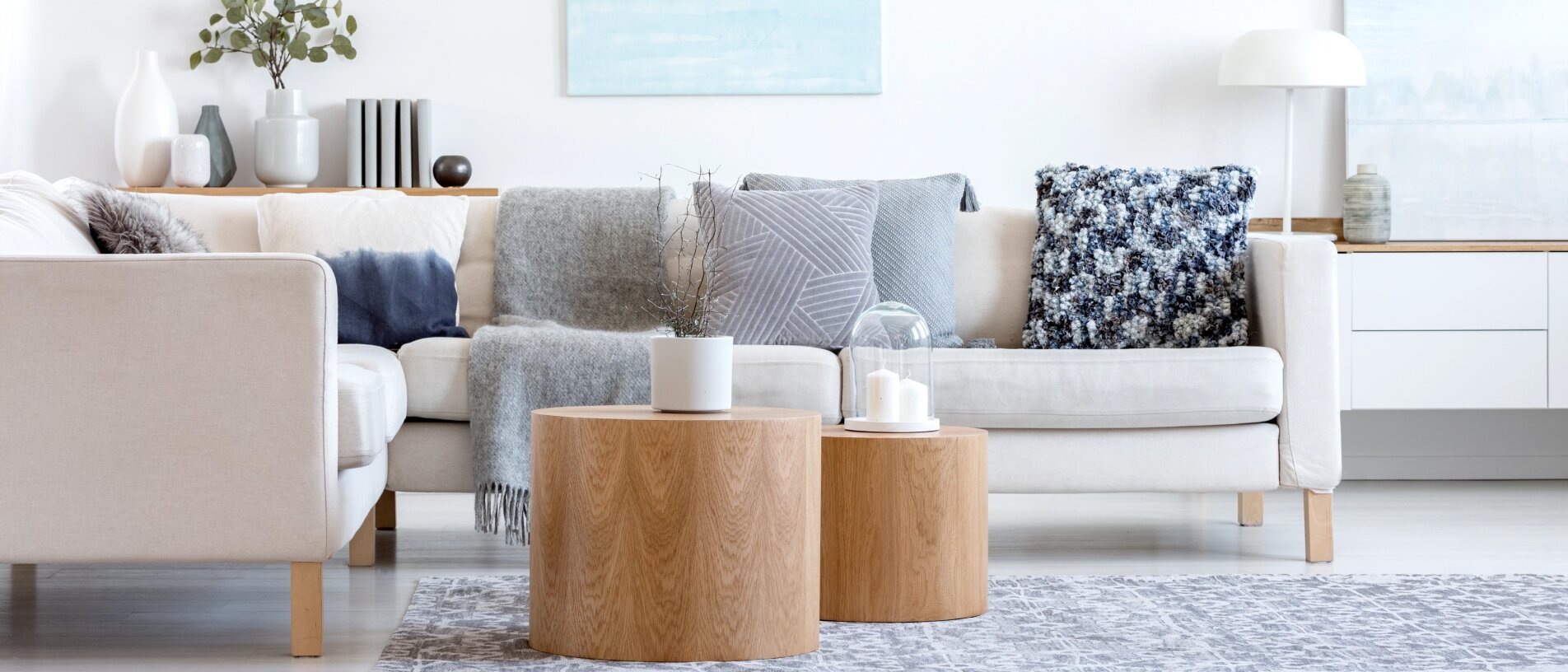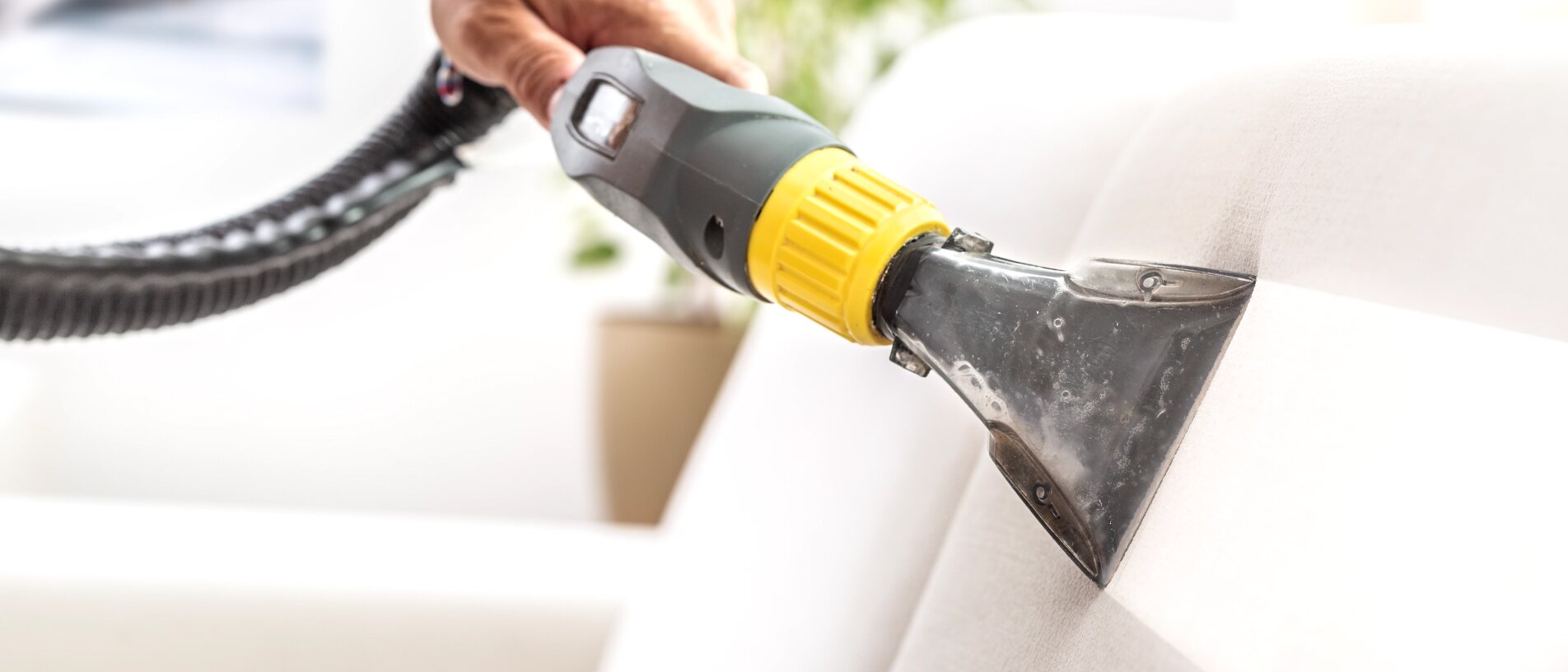You're on the list
By signing up, you agree to receive email marketing.


Upholstery does more than define the style of a piece of furniture. It also maximizes comfort and protects against daily wear, keeping your furniture looking and feeling brand new for years to come.
However, proper furniture care is essential to protect your investment. How you clean and care for upholstered furniture keeps the surface looking its best. When you maintain your upholstered furniture over the years, it can also extend the life of your favorite pieces.
From daily fabric maintenance to tackling spilled drinks, here are the basics of how to clean upholstery.
Before you even think about cleaning upholstery furniture, you first need to identify the fabric material. Here are a few popular upholstery material choices:
Linen
Cotton
Viscose
Rayon
Polyester
Wool
Velvet
Leather
Couches, chairs, and other upholstered furniture absorb dirt, oil, dust, fur, allergens, and more daily.
A weekly vacuum can help to pick up crumbs and dust, as well as occasional spot cleaning to handle any spillage. Every three to four weeks, a quick surface clean can keep your upholstered furniture looking its best. Aim for a deep clean every six months to remove accumulated dirt, dust, and debris.
If you’re facing stubborn stains, a persistent smell, or upholstered fabric that just doesn’t seem to get clean enough, it might be time to bring in a professional.
Professional upholstery cleaning services can penetrate the deeply embedded dirt, grime, and stains your at-home efforts might miss. They can also offer specific treatments, like pet odor removal, protective coatings, and leather refurbishment.
Upholstered furniture comes in a range of materials, from sleek leather to soft velvets. Each type of fabric demands its own type of care. Use the wrong fabric cleaner on a piece of upholstered furniture and you could end up staining or damaging the fabric.
Thankfully, most upholstered items come with a label that tells you the right type of cleaning method to use. So before you start cleaning, you’ll first need to find your furniture’s code on the label.
If you see the code W, then you can use water to clean the upholstery. That means spot cleaning with water or using a water-based cleanser.
Code S stands for solvents, which means you should avoid using water. Instead, the fabric should be cleaned with a solvent-based cleaning product to break down oil-based stains. Make sure you use a solvent cleaner specifically designed for upholstery.
The WS code means the fabric allows for both water and solvent cleaning. If the stain you’re cleaning is oil-based, it's best to use a solvent. A water-based cleaner works for water-based stains.
Unfortunately, an X on the tag means your furniture shouldn’t be cleaned with any liquids or solvents. Stick to vacuuming or dry brushing only.
Code D fabrics shouldn’t be cleaned by DIY methods. These upholstered fabrics are dry clean only.


Whether you’re deep cleaning an upholstery couch or giving your upholstered chair a quick spot treatment, it’s important to follow the right guidelines. Here's how to clean upholstered chairs, couches, sectionals, recliners, and more in a few simple steps.
Before you begin cleaning your upholstered furniture, gather the cleaning supplies you’ll need:
Vacuum
Cleaning brush
Upholstery cleaner (water or solvent-based)
Microfiber cloth
Steam cleaner (optional)
Next, vacuum the furniture, including the cushions. If you’re cleaning something with crevices like a couch, make sure you reach deep inside to get any fallen crumbs or debris. For any stuck hair or debris, use a small dry cleaning brush to remove it.
Using the code on the label, identify the right upholstery cleaner for your piece. Water-based cleaners should only be used for W and WS codes, while oil-based cleaners should only be used for S and WS codes.
Make sure you do a spot test first to avoid any risk of color damage.
Apply a small amount of your cleaning solution (or water) to the upholstery in small sections with a microfiber cloth. Instead of spraying the solution directly on the upholstery, first apply it to the cloth. Then gently rub the solution into your couch.
It’s important to let your furniture air dry. You can use a ceiling or box fan to help speed up this process.
If you have difficult-to-clean upholstery surfaces, stubborn odors, or specialty fabric types, you may need a professional cleaning. Professional upholstery cleaners have access to the kind of tools to lift deep stains, remove odor, and extract dirt and grime from deep inside your upholstered furniture.
They also know exactly what kind of cleaners to use with each fabric type, which saves you from the risk of staining or damaging the fabric.
For a deeper clean, you can use the power of steam to clean and disinfect your upholstery surfaces. Use an upholstery steam cleaner for best results, but a carpet cleaner with a brush attachment can also work.
Here are the basic steps to steam upholstery at home:
Prep the surface by pre-treating stains with a water or oil-based cleanser
Start passing the steam wand over the upholstery, pressing it gently into the fabric.
Work over small portions to give the surface time to dry faster.
Use fast strokes instead of slow movements to help lift stains and lessen the amount of water the fabric absorbs.
For tougher stains, pass the steamer over the area repeatedly until it starts to lift.
Use a fan or open window to speed up the drying process.
Upholstery fabrics marked with a W or WS can be safely washed in the washing machine. However, you have to use the right kind of detergent and select the correct settings.
Many upholstery fabrics are sensitive to temperature, so keep the water on cold. Instead of using a commercial laundry detergent, find a natural, non-dyed, or sensitive detergent to avoid staining.
After machine washing, you can put it in the dryer on low or hang it on a drying rack. While machine drying is still possible at cooler temperatures, air drying is a safer choice. Some materials may be prone to shrinkage in the heat.
In between cleanings, it’s important to keep up maintenance for your upholstered furniture. This will keep the look and feel of your fabric fresher for longer, making cleanings less frequent and staining less likely.
Here are a few tips to maintain your upholstery:
Use throws and covers if pets or children are in the family.
Do immediate spot cleaning for spills and stains.
Apply stain protection products.
Vacuum your upholstered furniture regularly.
Avoid direct sunlight.
Taking care of your upholstered furniture doesn’t have to be complicated. With regular vacuuming, spot cleaning, and deep cleaning, you can preserve the aesthetic appeal of your furniture while also extending its lifespan.
You're on the list
By signing up, you agree to receive email marketing.